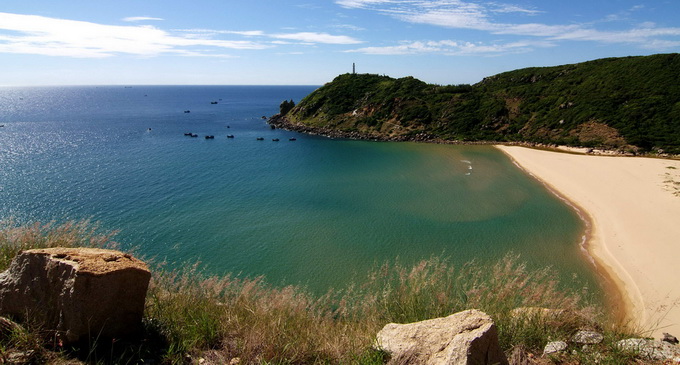Bai Mon - Mui Dien to Boost Phu Yen Tourism

With several national landscapes sitting in its area, the province of Phu Yen is considered a land of great potential for tourism industry development. With the series of projects and other efforts it has carried out over time, the province is fast-becoming one of the most attractive tourism destinations in the country. One of its three national-level vestiges, the Bai Mon Beach- Mui Dien Cape, will be among the strongest points to drive tourism to the area.
Part of the Dong Be hamlet, Hoa Tam commune, Dong Hoa district, the Bai Mon beach and Mui Dien cape are located next to each other allowing tourists to enjoy both attractions in one visit. From Bai Mon beach, tourists can easily walk across a small fresh-water stream and follow the mountain road towards the 400 steps climb to the 100-year old light-house station. The lighthouse was built by the French in 1890 to give directions for boats and ships operating in Vung Ro bay. After the wars, the light-house was ruined, but was restored in 1995.
Mui Dien is a part of Truong Son mountain range overlooking the sea. In particular, this place not only looks like a mountain and but also an island because there is the stream separating mountain from the land. Mui Dien cape is also known as Dai Lanh cape, Ke Ga cape or Cap Varella. The top is a beautiful venue to witness the first rays of the sun-rise on the mainland of Vietnam. Bai Mon beach, situated at the mountain foot of Mui Dien, is an attractive place with a 400-meter stretch of white sand. Mon beach is bordered by Mui Nay cape in the North and Mui Dien cape in the South. Where the cliff meets the gentle waves and blue pristine water, its sand is white, powdery and fine.
Coming to this area, tourists will be spoilt for wonderful views as within a radius of about 5 kilometers, they will get to explore all 3 national-level vestiges: the Bai Mon beach Mui Dien cape, Da Bia Mountain, and Vung Ro bay. In addition to many exotic beautiful beaches found in the province including Bai Goc beach, Bai Bang beach in the north, the preserved forest of North Deo Ca Pass is also a natural ecosystem of the mainland adjacent to the sea, and has strong potential for tourism development. Planned projects to promote tourism in the area would include facilities to accommodate activities like marine relaxation, marine sports, mountain climbing, sightseeing, and studying the eco-system of the sea and the forest.









